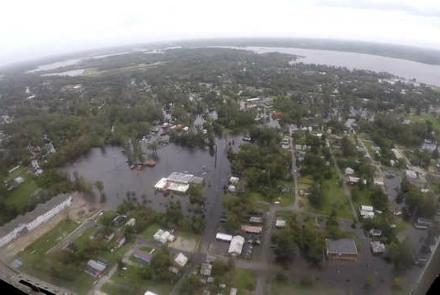Tropical Storm Florence dumped “epic” amounts of rain on North and South Carolina as it trudged inland on Saturday, knocking out power and causing at least eight deaths as flood waters that have devastated many communities kept rising.
Florence’s intensity has diminished since it roared ashore along the US mid-Atlantic coast on Friday as a hurricane. But its slow march over the two states, crawling west at only 6 km per hour, is expected to leave large parts of the region deluged in the coming days, the National Hurricane Center in Miami said late Saturday.
“This system is unloading epic amounts of rainfall, in some places measured in feet and not inches,” North Carolina Governor Roy Cooper told a news briefing. His state has already endured record rainfall, with much more forecast to come. Rivers will continue to rise days after the rain has stopped, he said.
“This is a hurricane event followed by a flood event,” said South Carolina Governor Henry McMaster.
With flood waters advancing rapidly in many communities, around 50 stranded people had been airlifted out by helicopter in North Carolina, said Petty Officer Michael Himes of the US Coast Guard. More than 26,000 hunkered down in shelters.
Numerous roads were closed, and authorities warned of the risk of landslides, tornadoes and flash floods, with dams and bridges in peril as rivers and creeks swelled. As of Saturday, about 676,000 homes and businesses were without power in North Carolina, along with 119,000 in South Carolina.
North Carolina officials said there had been at least seven storm-related fatalities in the state, with unconfirmed reports of a further three deaths.
South Carolina authorities reported one death.
The White House said President Donald Trump approved making federal funding available in some affected counties.
Trump, who plans a visit to the region next week, tweeted his “deepest sympathies and warmth” to the families and friends of those who had lost their lives.
WORST YET TO COME
At 2300 EDT (0300 GMT), the NHC said Florence had maximum sustained winds of 40 miles per hour (65 km), and was slowly drifting westward over South Carolina.
The center said the storm would dump as much as 102 cm of rain along coastal areas of the Carolinas, as well as up to 10 inches in southwestern Virginia.
In Fayetteville, a North Carolina city of about 210,000 people about 90 miles inland, authorities told thousands of residents near the Cape Fear River and Little River to get out of their homes by Sunday afternoon because of the flood risk.
“If you are refusing to leave during this mandatory evacuation, you need to do things like notify your legal next of kin because the loss of life is very, very possible,” Mayor Mitch Colvin said at a news conference.
“The worst is yet to come,” he added.
The storm made landfall on Friday near Wilmington, a city of about 120,000 squeezed between North Carolina’s Atlantic coastline and the Cape Fear River.
On Saturday, its streets were strewn with downed tree limbs and carpeted with leaves and other debris. Electricity remained out for much of the city, known for its historic mansions, with power lines lying across roads like wet strands of spaghetti.
Near the Sutton Power Plant in Wilmington, coal ash leaked from a Duke Energy landfill. The site lost enough material to fill around two-thirds of an Olympic-sized pool, the company said in a statement, adding that it did not believe the incident posed a risk to health or the environment.
Officials had warned before the storm that the rains could risk tainting waterways with murky coal ash and toxic hog waste.
Florence has already set a North Carolina record for rainfall totals, exceeding that of Hurricane Floyd, which struck in 1999 and caused 56 deaths. Floyd produced 24 inches of rain in some parts of the state, while Florence has already dumped about 30 inches in areas around Swansboro.
In New Bern, about 90 miles northeast of Wilmington at the confluence of two rivers, Florence overwhelmed the town of 30,000 and left the downtown area under water. Some area residents described a harrowing retreat as the storm hit.
“It was pitch black and I was just scared out of my mind,” said Tracy Singleton, who with her family later drove through torrential rain and high winds from her home near New Bern.
South Carolina authorities said law enforcement officers were guarding against looting in evacuated areas, while Wilmington set a curfew on Saturday evening in response to looting in one area.
As the United States dealt with Florence, a strong typhoon tore across the northern tip of the Philippines, wrecking homes and triggering landslides before heading toward Hong Kong and China.

